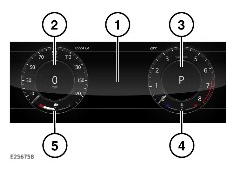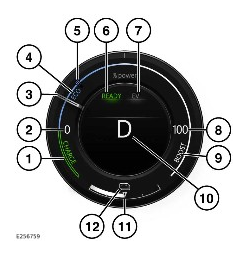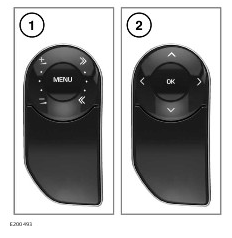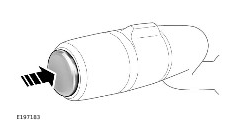2022 Land Rover Range Rover Sport Instrument Panel

INSTRUMENT PANEL
The instrument panel displays information, warnings, and menu options to the driver. See WARNING LAMPS AND INDICATORS. To configure the interactive driver display layout to suit personal preferences, select the Display and Display layout instrument panel menus. See INSTRUMENT PANEL MENU.
The displayed information automatically changes position, format, and content amount for each display layout option.
Select the Display and Units instrument panel menus to configure the temperature and tire pressure units.

The components of the instrument panel are as follows:
- Information panel: Displays information and menu selection options.
To configure the information panel display to suit personal preferences, select the Display and Info panel instrument panel menus.
- Speedometer: Displays the current vehicle speed.
- Tachometer: Displays the current engine speed, i.e., revolutions per minute (rpm).
- Temperature gauge: Displays the current engine temperature.
If the pointer moves onto the red line, the engine is overheating. In this event, the instrument panel illuminates the engine temperature warning lamp. See ENGINE TEMPERATURE (RED).
If the engine overheats, stop the vehicle as soon as safety permits. Allow the engine to idle until the temperature reduces. If the temperature does not reduce after several minutes, switch the engine off and allow it to cool. If the problem persists, seek qualified assistance immediately.
CAUTIONSerious engine damage occurs if the vehicle is driven while the engine is overheating.
NOTESIn the event of the engine overheating, a reduction in engine performance may occur. The Air Conditioning (A/C) system may also cease operation, to reduce the load on the engine and assist with engine cooling.
- Fuel gauge: Displays the current fuel tank level.
- An arrowhead symbol, next to the fuel pump symbol, indicates which side of the vehicle the fuel filler flap is located on.
- If the instrument panel illuminates the low fuel warning lamp, refuel the vehicle as soon as possible. See LOW FUEL WARNING (AMBER).
- To view the approximate driving distance for the current fuel level, press the trip button to select the Range trip content option. See USING THE TRIP COMPUTER.
Never allow the engine to run out of fuel. Doing so may cause serious damage to the vehicle’s fuel system.
INSTRUMENT PANEL: HYBRID VEHICLES
To configure the hybrid content display, select the Display and Hybrid content instrument panel menus. See INSTRUMENT PANEL MENU.
Select the required menu options display:
- Full hybrid display: The power gauge for the hybrid system is displayed, replacing the tachometer gauge.
- Reduced hybrid display: The tachometer is displayed, replacing the hybrid power gauge.
The power gauge and the tachometer only display in the Two dials or dial display layout options. If required, select the Display and Display layout instrument panel menus.
The tachometer automatically replaces the power gauge display in the event that:
- The dynamic driving program is selected. See TERRAIN RESPONSE OPERATION.
- The steering wheel paddle shifts are used to change gears with Sport (S) selected. See AUTOMATIC TRANSMISSION.
Some information displayed in both of the hybrid display options is as follows:
- The OFF and READY status.
- Gear selector status display.
- The hybrid battery charge gauge.
- The temperature gauge, if the current engine temperature exceeds normal operating temperatures.
The instrument panel displays the current hybrid battery charge and the total driving distance. The position and format changes for some Display layout instrument panel options.
The instrument panel displays hybrid information and the battery charge status when the vehicle is charged via an external power source. For example, connected to a charging station using the vehicle’s charging cable. See CONNECTING A CHARGING CABLE.

The hybrid power gauge displays information for the operation of the hybrid system.
The following information is displayed:
- CHARGE zone: When the vehicle is decelerating during braking or overrun, the electric motor regenerates energy and supplies a charge to the hybrid battery. The charge zone indicates the instantaneous amount of the regenerated energy.
- 0% POWER: Indicates when there is no energy being consumed or regenerated.
- Power gauge marker: Moves to indicate the current power being delivered by the engine and the electric motor.
- ECO zone: Driving in this zone helps to reduce energy consumption.
- Engine start marker: Displays when the Electric Vehicle (EV) mode is active and indicates the maximum power output of the electric motor. If the current power demand exceeds the start marker position, the engine is started for temporary use. In this event, the EV mode is suspended and the engine start marker illuminates gray. If the EV mode is deselected or canceled the engine start marker extinguishes.
- READY or OFF status: Indicates when the vehicle is ready to be driven.
- EV: Illuminates to confirm a selection of the EV mode via the center console button. See ELECTRIC VEHICLE (EV) MODE.
If selected, SAVE replaces EV. See SAVE.
- 100% POWER: Indicates the maximum power output for the engine.
- BOOST zone: Indicates when the engine and the electric motor are combined to increase the total power output.
- Gear selector status display.
- Battery gauge: Displays the current charge level of the high-voltage battery.
- Hybrid battery state of charge icon.
The state of charge icon is visible within the instrument panel and accompanies the battery gauge (11).
INSTRUMENT PANEL MENU
Do not operate the instrument panel controls while the vehicle is moving. Doing so may cause driver distraction, potentially resulting in an accident and causing serious injury or death. Use the instrument panel menus to configure the instrument panel display and some vehicle features. Use the controls mounted on the left side of the steering wheel to display and navigate through the instrument panel menus.

Operate the instrument panel menus as follows:
- MENU button: Press and release to display the instrument panel menus. The MENU button extinguishes and the OK button illuminates.
The menus do not display if the instrument panel displays any warning or information messages. In this event, press the OK button to clear each message after reading and taking any required action. See WARNING AND INFORMATION MESSAGES.
- Operate the buttons as follows:
Press the > button or the < button, to scroll through and highlight the required main menu option, displayed at the top of the information panel. The relevant sub-menu list is automatically displayed.
Press the ∧ button or the ∨ button, to scroll through the sub-menu list and highlight the required menu.
Press and release the OK button, to view the sub-list options for the highlighted sub-menu. Scroll up or down to the required option.
Press and release the OK button to select or deselect the required sub-list option.
Press and release the < button to return to the previous menu list.
Press and hold the < button to close and exit the instrument panel menus. The OK button extinguishes and the MENU button illuminates to confirm deselection.
The displayed menu options are as follows:
- Phone: Only available when a phone is connected.
- Media.
- Driver assistance.
- Trip.
- Display. The interactive driver display is configurable. Use the Display layout menu to select a Two dial, One dial, Full map, Media, or a Driver assistance view.
- Head-up display.
- Vehicle settings.
Before making any changes to the Vehicle settings, make sure to read and fully understand the relevant sections and topics of the Owner’s Handbook. Failure to do so can lead to serious injury or death.
- Vehicle info: Some options are only available before the engine starts.
WARNING AND INFORMATION MESSAGES
Do not ignore any warning or information messages displayed in the instrument panel. Take appropriate action as soon as possible. Failure to do so may result in death, serious injury, or serious damage to the vehicle. The instrument panel displays warning messages if specific driver action is required, or to accompany illuminated warning lamps. For example, in the event that a vehicle system fault is detected. The instrument panel displays information messages if specific driver action is required, or for driver information. For example, to confirm and assist with the selection or deselection of some vehicle features. To extinguish an instrument panel warning or information message, press the OK button on the steering wheel controls.
Extinguishing displayed warning and information messages does not clear or rectify a detected fault.
If a warning message is manually extinguished, the instrument panel illuminates an amber or red warning lamp until the cause of the message is rectified. If a persistent fault is detected, the warning message displays each time the ignition is switched on. In this event, follow any on-screen instructions or seek qualified assistance. Instrument panel messages are displayed in order of importance. If more than one instrument panel message is active, each message is displayed in turn for 2 seconds. High-importance warning messages are displayed first. The displayed warning messages can also be accompanied by an audible tone. Some warning messages can also display the handbook symbol. For information regarding warning messages and any action required, refer to the warning and information lamps section of the Owner’s Handbook. Follow any on-screen instructions, if displayed. The instrument panel displays a warning message until the detected fault is rectified.
USING THE TRIP COMPUTER
- The trip computer displays information and stores data for a series of trips.
- A trip is a distance traveled since the last memory reset via the trip computer.
- The maximum trip distance display is 9 999.9 (km or miles).
- The trip distance then automatically resets to zero.
- Select the Trip and Trip bank instrument panel menus to display the required trip, i.e., Trip A, Trip B, or Trip Auto. See INSTRUMENT PANEL MENU.
- The trip computer can be configured to display the trip units in miles or km.
- Select the Trip and Units instrument panel menus.
- To configure the trip content options to be available for display in the instrument panel, select the Trip and Content instrument panel menus.

Press and release the trip button to change the trip content option displayed in the instrument panel.
The available trip content options are as follows:
- Date.
- Average speed.
- Average economy.
- Instantaneous economy.
- Range.
- Battery range: Hybrid vehicles only.
- Trip distance.
Some of the trip content values can be reset to zero. Select and display the relevant trip content option. Press and hold the trip buttons for 2 seconds. The distance, average speed, and average fuel economy values for the trips can be reset. Set the trip computer display to show the required trip to reset. Press and hold the trip button until the instrument panel displays the Resetting message. Select the Trip and Trip Auto instrument panel menus to automatically reset Trip Auto each time the ignition is switched on. Select the Trip bank and Trip Auto instrument panel menus to add, or remove, another trip figure to the Trip Auto figure. Press the trip button for longer than 1 second, when the Trip Auto values for distance, average speed, and average fuel economy are displayed. The instrument panel displays either the Adding last journey or the Removing last journey message. Press the trip button for longer than 1 second to select the desired option. The previous trip information is added to or removed from, the Trip Auto value. The new total is displayed. There is no limit to the number of times this can be done before the ignition is switched off.
RANGE
The Range and Battery range displays show the predicted distance in miles or km that the vehicle can travel. See USING THE TRIP COMPUTER.

Range: Displays the total predicted driving distance for the current fuel tank level and the amount of charge in the hybrid battery.

Battery range: Displays the predicted driving distance for the amount of charge in the hybrid battery.
SERVICE INTERVAL INDICATOR
The next oil service interval can be displayed via the Vehicle info and Next service instrument panel menus. See INSTRUMENT PANEL MENU.
Dependent on the vehicle’s specification, other fluid intervals and capacities may also be displayed. The oil service interval displays as a distance left until the service are due. If the distance is exceeded, the display shows a negative (–) value to indicate that a service is overdue.
HEAD-UP DISPLAY (HUD)
Do not operate or adjust the Head-Up Display (HUD) system while the vehicle is moving. Doing so may cause driver distraction, potentially resulting in an accident and causing serious injury or death.
The HUD system may take more time to display in extreme temperatures, allowing the system to operate at the correct temperatures.
The full HUD image may not be viewed correctly while wearing polarized sunglasses.
Do not place anything over the HUD unit, which is located above the instrument panel, next to the windshield.
- In the interest of safety, only operate or adjust the HUD system when it is safe to do so.
- The HUD system projects some of the information currently displayed in the instrument panel onto the inside of the windshield.
- Use the Head-up display and Enable HUD instrument panel menus to switch the HUD system On or Off. See INSTRUMENT PANEL MENU.
- The HUD system also displays some instrument panel warning lamps. See WARNING LAMPS AND INDICATORS.
- Use the Head-up display and HUD content instrument panel menus to view a list of vehicle features for the HUD system to display.
- Select the required On or Off option for each feature.
- The HUD system only displays the vehicle features that are currently displayed in the instrument panel.
The position and format of the displayed HUD information vary due to priority and the number of features currently switched on or off. Setting the correct HUD position is important. The correct position is dependent on a number of conditions, including the height of the driver and the seat position.
- Before setting the position of the HUD, make sure that the driver’s seat is correctly positioned.
- The HUD level should be set horizontally, within the driver’s vision.
- Use the Head-up display and Position instrument panel menus to set the HUD position.
- Follow the on-screen instructions to adjust the HUD position using the steering wheel controls.
- Press the OK button to confirm and exit the menu.
- Preferences are stored using the driver’s seat memory store button. See SEAT POSITION MEMORY.
- The brightness of the HUD display is set automatically to suit the current ambient light conditions.
- To manually adjust the brightness, use the Head-up display and Brightness instrument panel menus.
- Follow the on-screen instructions to adjust the HUD brightness using the steering wheel controls. Press the OK button to confirm and exit the menu.
- The speedometer units displayed in the HUD system are the same as the instrument panel’s speedometer units.
- If cleaning is required, follow the cleaning instructions. See CLEANING SCREENS AND DISPLAYS.

